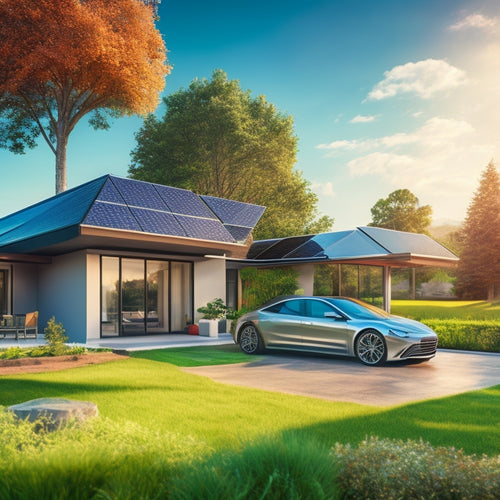
Sustainable Power for Warehouses: Renewable Energy Options
Share
You're looking to power your warehouse sustainably, and you're on the right track. Renewable energy options can substantially reduce your carbon footprint and operating costs. On-site solar panels, wind turbines, and geothermal systems can generate clean energy. Bioenergy from organic waste, hydrokinetic energy harvesting, and energy storage solutions can further reduce your reliance on non-renewable energy sources. Green power purchase agreements can provide a stable, long-term energy supply. As you explore these options, you'll uncover the perfect blend of sustainability and cost-effectiveness for your warehouse operations - and that's just the beginning.
Key Takeaways
• Warehouses can harness solar energy by analyzing roof orientation, slope, and shading to determine ideal solar panel placement.
• Wind energy can be generated through wind turbine installation, reducing reliance on non-renewable energy sources and lowering operating costs.
• Geothermal energy offers a sustainable solution for warehouses through heat pump technology, ground source systems, and passive design principles.
• Bioenergy from organic waste provides a unique opportunity to tackle waste management challenges and generate renewable energy for warehouses.
• Energy storage solutions, such as flow batteries, play a critical role in ensuring power reliability and integrating intermittent renewable energy sources.
On-Site Solar Panel Systems
You can generate your own clean energy with on-site solar panel systems, which convert sunlight into electrical power directly at your location.
By harnessing the sun's energy, you'll reduce your reliance on the grid and lower your carbon footprint.
To maximize energy production, this involves analyzing your roof's orientation, slope, and shading to determine the ideal placement of solar panels.
Roof optimization certifies that your system operates at peak efficiency, generating the most energy possible.
To monitor your energy production and consumption, you'll need an energy monitoring system.
This advanced technology provides real-time data on your energy usage, helping you identify areas of inefficiency and opportunities for improvement.
With energy monitoring, you'll be able to track your energy savings, receive alerts for potential issues, and make data-driven decisions to optimize your energy usage.
To guarantee that your system is running smoothly, you'll want to verify that your energy monitoring system is functioning correctly.
Wind Energy for Warehousing
As you consider wind energy for your warehousing operations, you'll need to assess the feasibility of wind turbine installation on your property.
This involves evaluating factors like wind speeds, turbine size, and noise regulations to facilitate a successful implementation.
Additionally, you'll want to explore energy storage solutions to stabilize the intermittent power generated by wind turbines and guarantee a reliable supply of electricity.
Wind Turbine Installation
Wind turbine installation at warehousing facilities can substantially reduce reliance on non-renewable energy sources and lower operating costs.
As you consider installing wind turbines at your warehouse, you'll want to verify that you're maximizing energy production while minimizing maintenance and noise disruptions.
Regular turbine maintenance is vital to optimize energy output and prevent costly repairs. Schedule regular inspections to check for worn-out parts, misaligned blades, and other potential issues. You can also implement a condition-based maintenance approach, where sensors and monitoring systems detect potential problems before they escalate.
To reduce noise levels, consider installing turbines with noise-reducing features, such as slower rotor speeds or unique blade designs. Additionally, strategically placing turbines in areas with lower wind speeds can minimize noise pollution.
Energy Storage Solutions
Capturing excess energy generated by wind turbines during periods of low demand and storing it for later use can substantially improve the overall efficiency of your warehousing facility's renewable energy system.
This is where energy storage solutions come in – a vital component in ensuring a reliable and resilient power supply.
As you explore energy storage options, you'll want to prioritize battery maintenance as a top priority. Regular maintenance is essential to extend the lifespan of your batteries, ensuring they operate at peak levels.
A well-maintained battery system will help you maximize energy storage capacity, reducing the risk of power outages and grid instability.
Speaking of grid resiliency, energy storage solutions can greatly enhance it. By storing excess energy generated during off-peak hours, you can reduce the strain on the grid during peak demand periods, contributing to a more stable and efficient energy distribution system.
Geothermal Heating and Cooling
As you explore geothermal heating and cooling, you'll discover that the Earth's natural insulation can be leveraged to reduce energy consumption.
By harnessing this natural advantage, heat pump technology can efficiently provide both heating and cooling.
You'll find that ground source systems, in particular, offer a promising solution for sustainable temperature control.
Earth's Natural Insulation
By tapping into the Earth's natural insulation, you can harness the planet's thermal energy to provide efficient heating and cooling solutions.
This approach leverages the Earth's consistent underground temperature, which remains relatively constant throughout the year, to regulate your warehouse's climate.
By incorporating passive design principles, you can maximize the benefits of geothermal heating and cooling.
This involves strategically placing thermal mass elements, such as concrete or brick, within your warehouse to absorb and release heat as needed.
During winter, the thermal mass absorbs heat from the Earth, releasing it to warm your space.
In the summer, the process reverses, as the thermal mass absorbs heat from your warehouse and releases it into the cooler Earth.
Heat Pump Technology
You can further enhance your warehouse's climate control by incorporating heat pump technology, which leverages the Earth's thermal energy to provide efficient heating and cooling. This innovative solution reduces your reliance on fossil fuels, contributing to significant carbon reduction. By tapping into the Earth's natural thermal energy, heat pumps offer a highly efficient way to regulate your warehouse's temperature.
Heat pump technology offers several key benefits:
High thermal efficiency: Heat pumps can achieve efficiencies of 300-400%, compared to traditional HVAC systems.
Low operating costs: By harnessing the Earth's energy, you can reduce your energy bills and minimize your carbon footprint.
Reliability and durability: Heat pumps are designed to last, with a lifespan of up to 20-30 years or more.
Flexibility and versatility: Heat pumps can be used for both heating and cooling, making them an ideal solution for warehouses with fluctuating temperature needs.
Ground Source Systems
Taking your warehouse's climate control to the next level, ground source systems, also known as geothermal heating and cooling, offer a highly efficient and sustainable solution by leveraging the Earth's natural temperature to provide consistent and reliable heating and cooling.
By tapping into the Earth's thermal energy, you can achieve high thermal efficiency, reducing your reliance on traditional HVAC systems. This is made possible by the Earth's ability to maintain a consistent temperature, ranging from 45°F to 70°F, depending on the region and soil properties.
In the winter, the Earth's natural heat is utilized to warm your warehouse, while in the summer, the Earth's cooler temperature helps to cool it. This results in significant energy savings and a reduced carbon footprint.
With a ground source system, you can expect to save up to 70% on your energy bills, making it an attractive option for warehouses looking to reduce their environmental impact.
Bioenergy From Organic Waste
One promising avenue for sustainable power generation involves harnessing bioenergy from organic waste, which can be converted into various forms of energy such as heat, electricity, or transportation fuels.
As you explore this option, you'll find that it offers a unique opportunity to tackle waste management challenges while generating clean energy.
Effective waste management is vital in this process, as it facilitates that organic waste is collected, processed, and converted into energy efficiently.
Anaerobic digestion, a biological process that breaks down organic matter in the absence of oxygen, is a common method used to convert waste into bioenergy.
Some benefits of bioenergy from organic waste include:
Renewable energy source: Bioenergy is a renewable energy source that reduces dependence on fossil fuels.
Waste reduction: Converting waste into energy reduces the amount of waste sent to landfills, minimizing environmental impacts.
Greenhouse gas reduction: Bioenergy production from organic waste reduces greenhouse gas emissions associated with waste decomposition.
Energy self-sufficiency: On-site bioenergy generation can provide a reliable source of energy for your warehouse operations.
Effective waste management is essential in this process, as it confirms that organic waste is collected, processed, and converted into energy efficiently.
Hydrokinetic Energy Harvesting
Harnessing the kinetic energy of moving water, hydrokinetic energy harvesting taps into the power of ocean tides, currents, and waves to generate electricity.
You're likely familiar with the immense force of ocean currents and tidal patterns, and it's astonishing to think that this energy can be harnessed to power your warehouse operations.
Hydrokinetic energy harvesting involves deploying underwater turbines or buoys that convert the kinetic energy of moving water into electrical energy.
This technology has immense potential, particularly in coastal regions with high tidal ranges or strong ocean currents.
For instance, the Gulf Stream, a powerful ocean current, could generate a substantial amount of electricity if harnessed effectively.
As you explore sustainable power options for your warehouse, hydrokinetic energy harvesting is definitely worth considering.
With the right infrastructure in place, you can tap into the predictable and reliable energy source that ocean currents and tidal patterns provide.
Energy Storage for Warehouses
As you shift to sustainable power options for your warehouse, you'll likely require a reliable energy storage system to stabilize and maintain a stable and efficient power supply. Energy storage solutions play a critical role in ensuring power reliability, especially when integrating intermittent renewable energy sources.
When selecting an energy storage system for your warehouse, consider the following key factors:
Flow Batteries: These batteries offer a scalable and cost-effective solution for long-duration energy storage, making them ideal for warehouses with high energy demands.
Depth of Discharge (DOD): A higher DOD allows for more efficient energy storage, but may reduce the battery's lifespan.
Round-Trip Efficiency: This measures the ratio of energy output to energy input, with higher efficiencies indicating a more efficient system.
Thermal Management: Proper thermal management is crucial to ensure the longevity and performance of your energy storage system.
Green Power Purchase Agreements
Your organization can substantially reduce its carbon footprint by entering into green power purchase agreements (GPPAs), which enable you to procure renewable energy directly from developers or generators.
This approach allows you to secure a stable, long-term energy supply while supporting the development of new renewable energy projects. By doing so, you'll not only reduce your reliance on fossil fuels but also mitigate risk associated with volatile energy markets.
GPPAs offer a unique opportunity for risk management, as they provide a fixed price for energy over a set period, typically 10-20 years. This stability is particularly valuable for warehouses, which require a consistent and reliable energy supply to operate efficiently.
In addition, GPPAs align with corporate social responsibility goals, as they demonstrate a commitment to reducing your organization's environmental impact. By investing in renewable energy, you'll not only reduce your carbon footprint but also enhance your reputation as a responsible corporate citizen.
Frequently Asked Questions
Can Renewable Energy Systems Be Integrated With Existing Warehouse Infrastructure?
You'll find that, yes, renewable energy systems can be integrated with existing warehouse infrastructure, but first, you'll need to conduct thorough energy audits to inform a well-designed system that meets your specific energy needs.
How Do Renewable Energy Sources Impact Warehouse Operations and Logistics?
You'll find that integrating renewable energy sources optimizes warehouse operations by reducing energy costs, increasing energy efficiency, and streamlining your supply chain, ultimately leading to enhanced logistical flexibility and a competitive edge.
Are There Incentives or Tax Credits for Adopting Renewable Energy in Warehouses?
You'll be pleased to know that, yes, there are incentives for adopting renewable energy in warehouses. You can tap into government rebates and energy incentives, which can substantially offset the costs of switching to clean power.
Can Renewable Energy Systems Be Scaled up or Down for Warehouses of Varying Sizes?
You'll find that renewable energy systems can be scaled up or down to fit your warehouse's unique needs, thanks to energy flexibility and modular design, allowing for a tailored approach to sustainable power.
How Do Renewable Energy Systems Impact the Overall Cost of Warehouse Operations?
You'll find that renewable energy systems substantially reduce your warehouse's energy expenditures, resulting in substantial energy savings. A thorough cost analysis will reveal the long-term benefits, allowing you to allocate resources more efficiently and boost your bottom line.
Related Posts
-

What Solar Panels Work Best With EVS Online?
When shopping for solar panels online to power your electric vehicle, look for high-efficiency models that can withst...
-

5 Essential Tips for Buying EV Charging Systems Online
When purchasing an EV charging system online, you'll want to make sure you're making an informed decision. First, det...
-

Top Online Stores for Solar Car Accessories
When searching online for solar car accessories, you'll find top retailers like Amazon, REI Co-op, and Best Buy offer...


